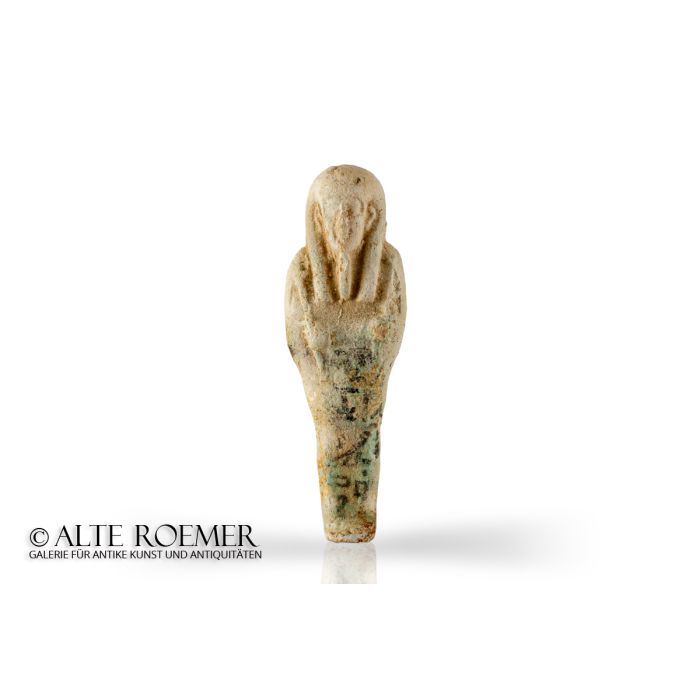Egyptian ushabti
Price: on request
Sold
Object number
AR3424C
| Object: |
Egyptian ushabti
|
| Material: |
Mint green faience with black painting.
|
| Period: |
Around 200 BC. Ptolemaic era of Ancient Egypt. |
| Description: |
Egyptian funerary statuette with a flat body in mummy posture. A pillar at the rear side. Wearing a tripartite wig and a god's beard. The arms are crossed in front of the chest. The ushabti holds agricultural implements in its hands, a hoe in his right hand, a flail in his left hand and a seed bag hanging over his shoulder. The front, sides and back is inscribed vertically with black painted hieroglyphs that are not deciphered. The statuette is an interesting mix of styles of black painted hieroglyphs, which are primarily known from the Third Intermediate Period, and the back pillar, which was only common from the Late Period onwards. It is in fact a piece from the Ptolemaic era, which takes up these stylistic features from earlier periods. |
| Background: |
In Ancient Egypt, a tradition of equipping the graves of the deceased with small funerary figurines gradually became established. The figurines were made of clay, stone, wood or metal, some were covered with faience. They were named with the ancient Egyptian word for "answerer". Transcriptions for this are ushabti, shabti or shawabti. Most commonly used and apparently popular were terracotta ushabtis covered with a fine greenish or blue faience. They were usually 10cm to 20cm tall. Those who could afford it had the ushabtis elaborately engraved or simply painted. The fine engravings of many pieces survived until today. Paint suffered more from the ravages of time, but fortunately some painted figures too have been preserved. The majority of the ushabtis found shows strong erosion and can only be recognized as such by their outlines. Or they were already that basic in their appearence when made in order to cut costs. Ushabtis have been resting with the deceased since the Middle Kingdom of Ancient Egypt around the beginning of the 2nd millennium BC. The earliest known figurines date from the 11th Dynasty. It seems they represented the dead initially, but their function changed until the New Kingdom. At that time the ushabti were to serve as workers in the afterlife, standing in for the deceased, so that he or she was freed from hard physical labour (6th chapter of the Book of the Dead). With this change in purpose it made sense to add more ushabtis to the grave increasing the labour force. This resulted in up to 365 ushabtis per tomb, e.g. for Tut-Anch-Amun - one "answerer" for each day of the solar year. Either the figures were placed directly in the grave or else richly painted or otherwise decorated vessels were used for storage, the best known type being the so-called wooden ushabti boxes. |
| Dimensions: |
10.2cm height.
|
| Condition: |
The body itself is perfectly preserved. Some surface wear, particularly in the upper area of the statuette.
|
| Provenance: |
Acquired by us on the US-American art market in 2022. Previously in the US-American private collection R. Rollinger. Into the collection from the inventory of Artasia Gallery, Los Angeles, USA. Added to the gallery's inventory in the 1970ies by purchase from an art dealer.
|
| References: |
Cf. H. A. Schloegl, Corpus der aegyptischen Totenfiguren der oeffentlichen Sammlungen Krakaus, p. 129, no. 84. Cf. British Museum, museum no. EA9073. |
| Literature: |
A good introduction and overview on Egyptian ushabtis in just one volume is given by Glenn Janes in Shabtis: A Private View - Ancient Egyptian Funerary Statuettes in European Private Collections.
|
| Authenticity: |
We unconditionally guarantee the authenticity of every artefact, all items are subject to our lifetime return policy on authenticity.
|


